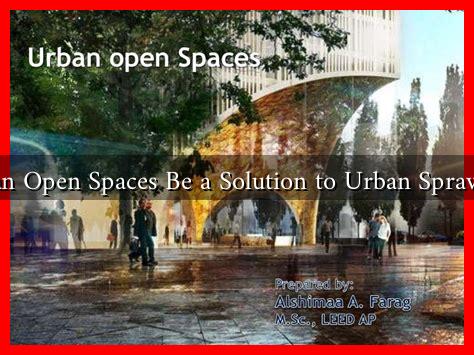-
Table of Contents
Can Open Spaces Be a Solution to Urban Sprawl?
Urban sprawl, characterized by the uncontrolled expansion of urban areas into the surrounding rural land, poses significant challenges for cities worldwide. As populations grow and cities expand, the need for sustainable solutions becomes increasingly urgent. One potential remedy lies in the strategic use of open spaces. This article explores how open spaces can mitigate the effects of urban sprawl, enhance community well-being, and promote environmental sustainability.
Understanding Urban Sprawl
Urban sprawl is often driven by a combination of factors, including population growth, economic development, and the desire for larger living spaces. However, this phenomenon can lead to several negative consequences:
- Increased traffic congestion and longer commute times
- Loss of agricultural land and natural habitats
- Higher infrastructure costs for municipalities
- Social isolation and reduced community cohesion
As cities expand outward, the need for effective planning and management becomes critical. Open spaces, including parks, greenways, and community gardens, can play a vital role in addressing these challenges.
The Role of Open Spaces in Urban Planning
Open spaces serve multiple functions in urban environments, providing recreational opportunities, enhancing biodiversity, and improving air quality. Here are some key benefits of integrating open spaces into urban planning:
- Promoting Healthy Lifestyles: Access to parks and recreational areas encourages physical activity, which can lead to improved public health outcomes.
- Enhancing Community Engagement: Open spaces can serve as gathering places for community events, fostering social connections and a sense of belonging.
- Environmental Benefits: Green spaces help mitigate urban heat, improve air quality, and support local wildlife.
- Economic Advantages: Well-maintained parks can increase property values and attract businesses, contributing to local economies.
Case Studies: Successful Integration of Open Spaces
Several cities around the world have successfully integrated open spaces into their urban planning strategies, demonstrating the potential of these areas to combat urban sprawl.
1. New York City, USA
New York City has made significant investments in its parks and open spaces, most notably through the High Line project. This elevated linear park transformed an abandoned railway into a vibrant green space, attracting millions of visitors annually and revitalizing the surrounding neighborhoods. The High Line has not only enhanced local property values but also served as a model for similar projects in other cities.
2. Singapore
Singapore is renowned for its innovative approach to urban planning, integrating nature into its dense urban environment. The city-state has developed a network of parks, green roofs, and vertical gardens, promoting biodiversity and improving residents’ quality of life. The Gardens by the Bay project exemplifies this approach, showcasing how open spaces can coexist with urban development.
3. Melbourne, Australia
Melbourne’s commitment to open spaces is evident in its extensive park system and the “20-Minute Neighbourhood” initiative, which aims to ensure that residents can access essential services and recreational areas within a 20-minute walk. This approach not only reduces reliance on cars but also fosters community interaction and well-being.
Challenges and Considerations
While open spaces offer numerous benefits, several challenges must be addressed to maximize their potential:
- Land Use Conflicts: Balancing development and conservation can be contentious, requiring careful planning and community involvement.
- Maintenance Costs: Ensuring that open spaces are well-maintained requires ongoing funding and resources.
- Equitable Access: It is essential to ensure that all community members have access to open spaces, regardless of socioeconomic status.
Conclusion
Open spaces can indeed be a viable solution to urban sprawl, offering numerous benefits that enhance community well-being and environmental sustainability. By promoting healthy lifestyles, fostering social connections, and providing ecological advantages, open spaces can transform urban landscapes. However, successful integration requires thoughtful planning, community engagement, and a commitment to equitable access. As cities continue to grow, prioritizing open spaces will be crucial in creating livable, sustainable urban environments for future generations.
For more information on urban planning and the role of open spaces, visit Urban Land Institute.

